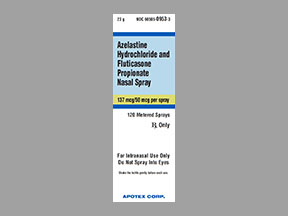
Azelastine-fluticasone Coupons & Savings Card – Discount Prices from $44.47
Generic for: Dymista
My prescription
Edit
23GM of 137-50MCG/ACT, Azelastine-fluticasone (1 Bottle)
Select pharmacy

CVS
$44.47
COUPON PRICE
Walgreens
$59.10
COUPON PRICE
Walmart
$62.30
COUPON PRICE
Albertsons
$85.21
COUPON PRICEAzelastine-fluticasone savings card
Show this card to your pharmacist
CVS
$44.47
BIN
ID
PCN
GRP
019876
LHD68E49A3
CHIPPO
LHX
Powered by
More prescriptions for allergic rhinitis
More prescriptions for allergic rhinitis
Price history for Dymista (brand) & Azelastine-fluticasone (generic)
1 Bottle, 23GM of 137-50MCG/ACT
Average retail price for Dymista
Average retail price for Azelastine-fluticasone
Average SaveHealth price for Azelastine-fluticasone
Our price history data is based on aggregated prescription data collected from participating pharmacies in America. Our prescription data updates daily to reflect the latest price changes. If you notice a missing data point, it means there wasn't sufficient data available to generate a monetary value for that date.
We analyzed Azelastine-fluticasone prices for (23GM of 137-50MCG/ACT, 1 Bottle) over the last 12 months. The average retail price was $195.61, while the average price using the SaveHealth discount card was $55.75. That's a savings of approximately 71.50% when using our Azelastine-fluticasone coupon.
Compared to the generic version, Dymista had an average price of $288.74 over the same time period. With the SaveHealth savings card, Azelastine-fluticasone is 80.69% cheaper on average than Dymista.
*Retail prices are based on pharmacy claims data, and may not be accurate when we don't have enough claims.
Azelastine-fluticasone dosage forms
Dosage Quantity Price from Per unit 23GM of 137-50MCG/ACT 1 Bottle $44.47 $44.47 23GM of 137-50MCG/ACT 2 Bottles $70.95 $35.48 23GM of 137-50MCG/ACT 3 Bottles $105.42 $35.14
| Dosage | Quantity | Price from | Per unit |
|---|---|---|---|
| 23GM of 137-50MCG/ACT | 1 Bottle | $44.47 | $44.47 |
| 23GM of 137-50MCG/ACT | 2 Bottles | $70.95 | $35.48 |
| 23GM of 137-50MCG/ACT | 3 Bottles | $105.42 | $35.14 |
Azelastine-fluticasone Warnings
This document provides crucial safety and warning information regarding the use of Dymista (azelastine/fluticasone). It is essential to review these warnings and discuss any concerns with your healthcare provider.
Drowsiness: Dymista can cause drowsiness. Refrain from driving or engaging in activities that require full attention until you understand how the medication affects you. Alcohol may intensify this effect, so it is advised to avoid it while using Dymista.
Nasal Issues: Some users may experience nosebleeds or damage to the nasal tissues, potentially leading to serious injury to the nasal septum. Healing of nasal injuries may be impaired. Those with recent nasal surgery, existing nasal injuries, or ulcers should exercise caution.
Infection Risk: Corticosteroids like fluticasone in Dymista can increase the risk of infections, including fungal infections in the nose or throat, and viral infections such as chickenpox. The risk is higher with prolonged use or when taking other immune-suppressing medications.
Hormonal Effects: Long-term or excessive use of Dymista can lead to increased absorption of the medication, impacting stress hormone levels due to its similarity to cortisol. Use the medication as prescribed to minimize this risk.
Growth Concerns in Children: Fluticasone may slow growth in children. To mitigate this, use the lowest effective dose for the shortest duration. Consult a pediatrician to ensure appropriate use for your child.
Allergic Reactions: Potential allergic reactions to Dymista may include severe facial swelling, shock, and anaphylaxis. Seek immediate medical help if you experience hives, rash, swelling, or breathing difficulties.
Eye Health: Though rare, Dymista may increase eye pressure, leading to vision issues such as glaucoma or cataracts. If you have a history of eye pressure problems, discuss with your eye specialist before using this medication and report any vision changes promptly.
In case of an overdose or severe reactions, seek emergency medical attention immediately. Always use Dymista as directed by your healthcare provider and report any unusual symptoms promptly.
Azelastine-fluticasone Side Effects
Common side effects:
- Drowsiness
- Nasal dryness or irritation
- Mild nosebleeds
- Changes in taste
Less common but important to monitor:
- Severe nosebleeds
- Pain in the nose
- A whistling sound when breathing
- Eye pain
- Persistent sore throat
- White patches in the nose or back of the throat
- Fever
- Chills
Serious side effects:
- Unusual tiredness
- Weight loss
- Headaches
- Swelling of the ankles or feet
- Increased thirst or urination
- Vision problems
- Very serious allergic reaction (rash, severe dizziness, itching, swelling of the face, tongue, or throat, trouble breathing)
Azelastine-fluticasone Interactions
Interactions with high risk of serious adverse effects and should be avoided:
- lopinavir
- Ritonavir
Interactions with moderate risk that may require dose adjustment, closer monitoring, or timing changes:
- opioid pain or cough medications (such as codeine, hydrocodone)
- alcohol
- marijuana (cannabis)
- sleep or anxiety medications (such as Alprazolam, Lorazepam, Zolpidem)
- muscle relaxants (such as Carisoprodol, Cyclobenzaprine)
- other antihistamines (such as Cetirizine, diphenhydramine)
